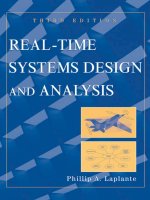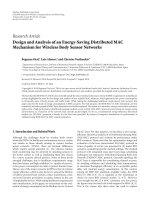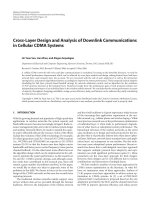real-time systems design and analysis an engineers handbook
Bạn đang xem bản rút gọn của tài liệu. Xem và tải ngay bản đầy đủ của tài liệu tại đây (5.58 MB, 530 trang )
REAL-TIME SYSTEMS
DESIGN AND ANALYSIS
THIRD EDITION
Phillip A. Laplante
A JOHN WILEY & SONS, INC., PUBLICATION
REAL-TIME SYSTEMS
DESIGN AND ANALYSIS
IEEE Press
445 Hoes Lane
Piscataway, NJ 08854
IEEE Press Editorial Board
Stamatios V. Kartalopoulos, Editor in Chief
M. Akay M. E. El-Hawary F. M. B. Periera
J. B. Anderson R. Leonardi C. Singh
R. J. Baker M. Montrose S. Tewksbury
J. E. Brewer M. S. Newman G. Zobrist
Kenneth Moore, Director of Book and Information Services (BIS)
Catherine Faduska, Senior Acquisitions Editor
John Griffin, Acquisitions Editor
Anthony VenGraitis, Project Editor
REAL-TIME SYSTEMS
DESIGN AND ANALYSIS
THIRD EDITION
Phillip A. Laplante
A JOHN WILEY & SONS, INC., PUBLICATION
TRADEMARKS
68000 is a registered trademark of Motorola.
80386, 80486 are registered trademarks of Intel Corporation.
CICS is a trademark of IBM.
OS/2 is a trademark of IBM.
Presentation Manager is a trademark of IBM.
Software Through Pictures is a trademark of Aonix.
Space Invaders is a trademark of Taito
SPARC is a trademark of Sun Microsystems.
STATEMATE is a trademark of i-Logix.
UNIX is a trademark of AT&T.
VAX is a trademark of Digital Equipment Corporation.
Copyright 2004 by the Institute of Electrical and Electronics Engineers, Inc. All rights reserved.
Published simultaneously in Canada.
No part of this publication may be reproduced, stored in a retrieval system, or transmitted in any form or by any
means, electronic, mechanical, photocopying, recording, scanning, or otherwise, except as permitted under
Section 107 or 108 of the 1976 United States Copyright Act, without either the prior written permission of the
Publisher, or authorization through payment of the appropriate per-copy fee to the Copyright Clearance Center,
Inc., 222 Rosewood Drive, Danvers, MA 01923, 978-750-8400, fax 978-750-4470, or on the web at
Department, John Wiley & Sons, Inc., 111 River Street, Hoboken, NJ 07030, (201) 748-6011, fax (201)
748-6008.
Limit of Liability/Disclaimer of Warranty: While the publisher and author have used their best efforts in
preparing this book, they make no representations or warranties with respect to the accuracy or completeness of
the contents of this book and specifically disclaim any implied warranties of merchantability or fitness for a
particular purpose. No warranty may be created or extended by sales representatives or written sales materials.
The advice and strategies contained herein may not be suitable for your situation. You should consult with a
professional where appropriate. Neither the publisher nor author shall be liable for any loss of profit or any other
commercial damages, including but not limited to special, incidental, consequential, or other damages.
For general information on our other products and services please contact our Customer Care Department within
the U.S. at 877-762-2974, outside the U.S. at 317-572-3993 or fax 317-572-4002.
Wiley also publishes its books in a variety of electronic formats. Some content that appears in print, however,
may not be available in electronic format.
Library of Congress Cataloging-in-Publication Data:
Laplante, Phillip A.
Real-time systems design and analysis : an engineer’s handbook / Phillip A. Laplante. –3rd ed.
p. cm.
Includes bibliographical references and index.
ISBN 0-471-22855-9 (cloth)
1. Real-time data processing. 2. System design. I. Title.
QA76.54.L37 2004
004
.33–dc22
2003065702
Printed in the United States of America.
10987654321
www.copyright.com. Requests to the Publisher for permission should be addressed to the Permissions
To my daughter, Charlotte
CONTENTS
Preface to the Third Edition xvii
1 Basic Real-Time Concepts 1
1.1 Terminology / 1
1.1.1 Systems Concepts / 2
1.1.2 Real-Time Definitions / 4
1.1.3 Events and Determinism / 7
1.1.4 CPU Utilization / 10
1.2 Real-Time System Design Issues / 12
1.3 Example Real-Time Systems / 13
1.4 Common Misconceptions / 15
1.5 Brief History / 16
1.5.1 Theoretical Advances / 17
1.5.2 Early Systems / 17
1.5.3 Hardware Developments / 18
1.5.4 Early Software / 18
1.5.5 Commercial Operating System Support / 19
1.6 Exercises / 20
2 Hardware Considerations 23
2.1 Basic Architecture / 23
2.2 Hardware Interfacing / 24
2.2.1 Latching / 24
2.2.2 Edge versus Level Triggered / 25
2.2.3 Tristate Logic / 25
2.2.4 Wait States / 26
2.2.5 Systems Interfaces and Buses / 26
2.3 Central Processing Unit / 29
2.3.1 Fetch and Execute Cycle / 30
2.3.2 Microcontrollers / 30
vii
viii CONTENTS
2.3.3 Instruction Forms / 31
2.3.4 Core Instructions / 33
2.3.5 Addressing Modes / 36
2.3.6 RISC versus CISC / 37
2.4 Memory / 38
2.4.1 Memory Access / 39
2.4.2 Memory Technologies / 39
2.4.3 Memory Hierarchy / 42
2.4.4 Memory Organization / 43
2.5 Input/Output / 44
2.5.1 Programmed Input/Output / 44
2.5.2 Direct Memory Access / 45
2.5.3 Memory-Mapped Input/Output / 46
2.5.4 Interrupts / 48
2.6 Enhancing Performance / 55
2.6.1 Locality of Reference / 55
2.6.2 Cache / 55
2.6.3 Pipelining / 56
2.6.4 Coprocessors / 58
2.7 Other Special Devices / 58
2.7.1 Applications-Specific Integrated Circuits / 58
2.7.2 Programmable Array Logic/Programmable Logic
Array / 59
2.7.3 Field-Programmable Gate Arrays / 59
2.7.4 Transducers / 62
2.7.5 Analog/Digital Converters / 64
2.7.6 Digital/Analog Converters / 64
2.8 Non-von-Neumann Architectures / 64
2.8.1 Parallel Systems / 65
2.8.2 Flynn’s Taxonomy for Parallelism / 65
2.9 Exercises / 70
3 Real-Time Operating Systems 73
3.1 Real-Time Kernels / 73
3.1.1 Pseudokernels / 74
3.1.2 Interrupt-Driven Systems / 79
3.1.3 Preemptive-Priority Systems / 82
3.1.4 Hybrid Systems / 83
3.1.5 The Task-Control Block Model / 86
3.2 Theoretical Foundations of Real-Time Operating Systems / 88
3.2.1 Process Scheduling / 90
3.2.2 Round-Robin Scheduling / 91
3.2.3 Cyclic Executives / 92
CONTENTS ix
3.2.4 Fixed-Priority Scheduling–Rate-Monotonic
Approach / 94
3.2.5 Dynamic-Priority Scheduling: Earliest-Deadline–First
Approach / 96
3.3 Intertask Communication and Synchronization / 98
3.3.1 Buffering Data / 99
3.3.2 Time-Relative Buffering / 99
3.3.3 Ring Buffers / 101
3.3.4 Mailboxes / 102
3.3.5 Queues / 104
3.3.6 Critical Regions / 104
3.3.7 Semaphores / 105
3.3.8 Other Synchronization Mechanisms / 111
3.3.9 Deadlock / 111
3.3.10 Priority Inversion / 117
3.4 Memory Management / 122
3.4.1 Process Stack Management / 122
3.4.2 Run-Time Ring Buffer / 126
3.4.3 Maximum Stack Size / 126
3.4.4 Multiple-Stack Arrangements / 126
3.4.5 Memory Management in the Task-Control-Block
Model / 127
3.4.6 Swapping / 128
3.4.7 Overlays / 128
3.4.8 Block or Page Management / 129
3.4.9 Replacement Algorithms / 131
3.4.10 Memory Locking / 132
3.4.11 Working Sets / 132
3.4.12 Real-Time Garbage Collection / 132
3.4.13 Contiguous File Systems / 133
3.4.14 Building versus Buying Real-Time Operating
Systems / 133
3.4.15 Selecting Real-Time Kernels / 134
3.5 Case Study: POSIX / 139
3.5.1 Threads / 139
3.5.2 POSIX Mutexes and Condition Variables / 142
3.5.3 POSIX Semaphores / 143
3.5.4 Using Semaphores and Shared Memory / 144
3.5.5 POSIX Messages / 145
3.5.6 Real-Time POSIX Signals / 148
3.5.7 Clocks and Timers / 149
3.5.8 Asynchronous Input and Output / 153
3.5.9 POSIX Memory Locking / 154
3.6 Exercises / 156
x CONTENTS
4 Software Requirements Engineering 161
4.1 Requirements-Engineering process / 161
4.2 Types of Requirements / 162
4.3 Requirements Specification for Real-Time Systems / 164
4.4 Formal Methods in Software Specification / 165
4.4.1 Limitations of Formal Methods / 167
4.4.2 Z / 168
4.4.3 Finite State Machines / 168
4.4.4 Statecharts / 172
4.4.5 Petri Nets / 174
4.4.6 Requirements Analysis with Petri Nets / 177
4.5 Structured Analysis and Design / 178
4.6 Object-Oriented Analysis and the Unified Modeling
Language / 180
4.6.1 Use Cases / 181
4.6.2 Class Diagram / 182
4.6.3 Recommendations on Specification Approach for
Real-Time Systems / 182
4.7 Organizing the Requirements Document / 183
4.8 Organizing and Writing Requirements / 184
4.9 Requirements Validation and Review / 186
4.9.1 Requirements Validation Using Model Checking / 187
4.9.2 Automated Checking of Requirements / 187
4.10 Appendix: Case Study in Software Requirements Specification
for Four-Way Traffic Intersection Traffic Light Controller
System / 190
4.11 Exercises / 222
5 Software System Design 225
5.1 Properties of Software / 225
5.1.1 Reliability / 226
5.1.2 Correctness / 228
5.1.3 Performance / 228
5.1.4 Usability / 229
5.1.5 Interoperability / 229
5.1.6 Maintainability / 229
5.1.7 Portability / 230
5.1.8 Verifiability / 230
5.1.9 Summary of Software Properties and Associated
Metrics / 231
5.2 Basic Software Engineering Principles / 231
5.2.1 Rigor and Formality / 231
5.2.2 Separation of Concerns / 231
CONTENTS xi
5.2.3 Modularity / 232
5.2.4 Anticipation of Change / 234
5.2.5 Generality / 235
5.2.6 Incrementality / 235
5.2.7 Traceability / 235
5.3 The Design Activity / 236
5.4 Procedural-Oriented Design / 237
5.4.1 Parnas Partitioning / 238
5.4.2 Structured Design / 239
5.4.3 Design in Procedural Form Using Finite State
Machines / 246
5.5 Object-Oriented Design / 247
5.5.1 Benefits of Object Orientation / 248
5.5.2 Design Patterns / 249
5.5.3 Object-Oriented Design Using the Unified Modeling
Language / 250
5.6 Appendix: Case Study in Software Requirements Specification
for Four-Way Traffic Intersection Traffic Light Controller
System / 255
5.7 Exercises / 318
6 Programming Languages and the Software Production Process 321
6.1 Introduction / 321
6.2 Assembly Language / 322
6.3 Procedural Languages / 323
6.3.1 Parameter Passing Techniques / 324
6.3.2 Call-by-Value and Call-by-Reference / 324
6.3.3 Global Variables / 325
6.3.4 Recursion / 325
6.3.5 Dynamic Memory Allocation / 325
6.3.6 Typing / 326
6.3.7 Exception Handling / 327
6.3.8 Modularity / 328
6.3.9 Cardelli’s Metrics and Procedural Languages / 329
6.4 Object-Oriented Languages / 329
6.4.1 Synchronizing Objects / 330
6.4.2 Garbage Collection / 331
6.4.3 Cardelli’s Metrics and Object-Oriented Languages / 333
6.4.4 Object-Oriented versus Procedural Languages / 334
6.5 Brief Survey of Languages / 336
6.5.1 Ada 95 / 336
6.5.2 C / 337
6.5.3 C++ / 338
6.5.4 C# / 339
xii CONTENTS
6.5.5 Fortran / 340
6.5.6 Java / 341
6.5.7 Occam 2 / 345
6.5.8 Special Real-Time Languages / 346
6.5.9 Know the Compiler and Rules of Thumb / 346
6.6 Coding Standards / 347
6.7 Exercises / 349
7 Performance Analysis And Optimization 351
7.1 Theoretical Preliminaries / 351
7.1.1 NP-Completeness / 351
7.1.2 Challenges in Analyzing Real-Time Systems / 352
7.1.3 The Halting Problem / 353
7.1.4 Amdahl’s Law / 355
7.1.5 Gustafson’s Law / 356
7.2 Performance Analysis / 357
7.2.1 Code Execution Time Estimation / 357
7.2.2 Analysis of Polled Loops / 364
7.2.3 Analysis of Coroutines / 364
7.2.4 Analysis of Round-Robin Systems / 364
7.2.5 Response-Time Analysis for Fixed-Period Systems / 367
7.2.6 Response-Time Analysis: RMA Example / 368
7.2.7 Analysis of Sporadic and Aperiodic Interrupt
Systems / 368
7.2.8 Deterministic Performance / 369
7.3 Application of Queuing Theory / 370
7.3.1 The M/M/1 Queue / 370
7.3.2 Service and Production Rates / 371
7.3.3 Some Buffer-Size Calculations / 372
7.3.4 Response-Time Modeling / 372
7.3.5 Other Results from Queuing Theory / 373
7.3.6 Little’s Law / 373
7.3.7 Erlang’s Formula / 374
7.4 I/O Performance / 375
7.4.1 Basic Buffer-Size Calculation / 375
7.4.2 Variable Buffer-Size Calculation / 376
7.5 Performance Optimization / 377
7.5.1 Compute at Slowest Cycle / 377
7.5.2 Scaled Numbers / 377
7.5.3 Binary Angular Measure / 378
7.5.4 Look-Up Tables / 379
7.5.5 Imprecise Computation / 380
7.5.6 Optimizing Memory Usage / 381
7.5.7 Postintegration Software Optimization / 381
CONTENTS xiii
7.6 Results from Compiler Optimization / 381
7.6.1 Use of Arithmetic Identifies / 382
7.6.2 Reduction in Strength / 382
7.6.3 Common Subexpression Elimination / 383
7.6.4 Intrinsic Functions / 383
7.6.5 Constant Folding / 383
7.6.6 Loop Invariant Optimization / 384
7.6.7 Loop Induction Elimination / 384
7.6.8 Use of Registers and Caches / 385
7.6.9 Removal of Dead or Unreachable Code / 385
7.6.10 Flow-of-Control Optimization / 385
7.6.11 Constant Propagation / 386
7.6.12 Dead-Store Elimination / 386
7.6.13 Dead-Variable Elimination / 387
7.6.14 Short-Circuiting Boolean Code / 387
7.6.15 Loop Unrolling / 387
7.6.16 Loop Jamming / 388
7.6.17 More Optimization Techniques / 389
7.6.18 Combination Effects / 390
7.6.19 Speculative Execution / 391
7.7 Analysis of Memory Requirements / 391
7.8 Reducing Memory Utilization / 392
7.8.1 Variable Selection / 392
7.8.2 Memory Fragmentation / 393
7.9 Exercises / 393
8 Engineering Considerations 397
8.1 Metrics / 397
8.1.1 Lines of Code / 397
8.1.2 McCabe’s Metric / 398
8.1.3 Halstead’s Metrics / 399
8.1.4 Function Points / 401
8.1.5 Feature Points / 404
8.1.6 Metrics for Object-Oriented Software / 405
8.1.7 Objections to Metrics / 406
8.1.8 Best Practices / 406
8.2 Faults, Failures, and Bugs / 406
8.2.1 The Role of Testing / 407
8.2.2 Testing Techniques / 407
8.2.3 System-Level Testing / 413
8.2.4 Design of Testing Plans / 415
8.3 Fault-Tolerance / 415
8.3.1 Spatial Fault-Tolerance / 416
8.3.2 Software Black Boxes / 417
xiv CONTENTS
8.3.3 N-Version Programming / 418
8.3.4 Built-In-Test Software / 418
8.3.5 CPU Testing / 418
8.3.6 Memory Testing / 419
8.3.7 ROM / 419
8.3.8 RAM / 420
8.3.9 Other Devices / 422
8.3.10 Spurious and Missed Interrupts / 422
8.3.11 Handling Spurious and Missed Interrupts / 422
8.3.12 The Kalman Filter / 423
8.4 Systems Integration / 424
8.4.1 Goals of System Integration / 425
8.4.2 System Unification / 425
8.4.3 System Verification / 425
8.4.4 System Integration Tools / 426
8.4.5 A Simple Integration Strategy / 429
8.4.6 Patching / 430
8.4.7 The Probe Effect / 431
8.4.8 Fault-Tolerant Design: A Case Study / 432
8.5 Refactoring Real-Time Code / 436
8.5.1 Conditional Logic / 436
8.5.2 Data Clumps / 436
8.5.3 Delays as Loops / 437
8.5.4 Dubious Constraints / 437
8.5.5 Duplicated Code / 437
8.5.6 Generalizations Based on a Single Architecture / 438
8.5.7 Large Procedures / 438
8.5.8 Lazy Procedure / 438
8.5.9 Long Parameter List / 438
8.5.10 Message-Passing Overload / 438
8.5.11 Self-Modifying Code / 439
8.5.12 Speculative Generality / 439
8.5.13 Telltale Comments / 439
8.5.14 Unnecessary Use of Interrupts / 439
8.6 Cost Estimation Using COCOMO / 440
8.6.1 Basic COCOMO / 440
8.6.2 Intermediate and Detailed COCOMO / 441
8.6.3 COCOMO II / 442
8.7 Exercises / 443
CONTENTS xv
Glossary 445
Bibliography 475
Index 487
About the Author 505
PREFACE TO THE
THIRD EDITION
This book is an introduction to real-time systems. It is intended not as a cookbook,
but, rather, as a stimulus for thinking about hardware and software in a different
way. It is necessarily broader than deep. It is a survey book, designed to heighten
the reader’s awareness of real-time issues.
This book is the culmination of more than 20 years of building, studying, and
teaching real-time systems. The author’s travels have taken him to NASA, UPS,
Lockheed Martin, the Canadian and Australian Defense Forces, MIT’s Charles
Stark Draper Labs, and many other places. These visits and interactions with
literally hundreds of students from such places as Boeing, Motorola, and Siemens
have resulted in a wider understanding of real-time systems and particularly their
real application. This book is, in essence, a compendium of these experiences.
The author’s intent is to provide a practical framework for software engineers
to design and implement real-time systems. This approach is somewhat different
from that of other texts on the subject.
Because of the pragmatic approach, a few of the results and viewpoints pre-
sented book’s may be controversial. The author has adapted many of the formal
definitions from their traditional rigid form into words that are more compatible
with practical design. In many places theoretical treatments have been omitted
where they would have obscured applied results. In these cases, the reader is
referred to additional reading. This author is a great believer in research in this
area, and in many places has indicated where research needs to be done or is
being done.
Although the book may appear simplistic, it is subtly complex. Consider the
semaphore operators. They can be written with a minimum amount of code, yet
they are fraught with danger for the real-time designer. In the same way, this
book has a kind of Zen-like simplicity and complexity: a yin and a yang.
INTENDED AUDIENCE
This text is an introductory-level book intended for junior–senior level and grad-
uate computer science and electrical engineering students, and practicing software
engineers. It can be used as a graduate-level text if it is supplemented with an
xvii
xviii PREFACE TO THE THIRD EDITION
advanced reader, such as one by the author [Laplante00]. This book is especially
useful in an industrial setting for new real-time systems designers who need to
get “up to speed” very quickly. This author has used earlier editions of this book
in this way to teach short courses for several clients.
The reader is assumed to have some experience in programming in one of the
more popular languages, but other than this, the prerequisites for this text are
minimal. Some familiarity with discrete mathematics is helpful in understanding
some of the formalizations, but it is not essential. A background in basic calculus
and probability theory will assist in the reading of Chapter 7.
PROGRAMMING LANGUAGES
Although there are certain “preferred” languages for real-time system design,
such as C, C++, Ada 95, and increasingly Java, many real-time systems are still
written in Fortran, assembly language, and even Visual BASIC. It would be unjust
to focus this book on one language, say C, when the theory should be language
independent. However, for uniformity of discussion, points are illustrated, as
appropriate, in generic assembly language and C. While the C code is not intended
to be ready-to-use, it can be easily adapted with a little tweaking for use in a
real system.
ORGANIZATION OF THE BOOK
Real-time software designers must be familiar with computer architecture and
organization, operating systems, software engineering, programming languages,
and compiler theory. The text provides an overview of these subjects from the
perspective of the real-time systems designer. Because this is a staggering task,
depth is occasionally sacrificed for breadth. Again, suggestions for additional
readings are provided where depth has been sacrificed.
The book is organized into chapters that are essentially self-contained. Thus,
the material can be rearranged or omitted, depending on the background and inter-
ests of the audience or instructor. Each chapter contains both easy and challenging
exercises that stimulate the reader to confront actual problems. The exercises,
however, cannot serve as a substitute for practical experience.
The first chapter provides an overview of the nature of real-time systems. Much
of the basic vocabulary relating to real-time systems is developed along with a
discussion of the challenges facing the real-time system designer. Finally, a brief
historical review is given. The purpose of this chapter is to foreshadow the rest
of the book as well as quickly acquaint the reader with pertinent terminology.
The second chapter presents a more detailed review of basic computer archi-
tecture concepts from the perspective of the real-time systems designer and some
basic concepts of electronics. Specifically, the impact of different architectural
features on real-time performance is discussed. The remainder of the chapter
PREFACE TO THE THIRD EDITION xix
discusses different memory technologies, input/output techniques, and peripheral
support for real-time systems. The intent here is to increase the reader’s awareness
of the impact of the computer architecture on design considerations.
Chapter 3 provides the core elements of the text for those who are building
practical real-time systems. This chapter describes the three critical real-time
kernel services: scheduling/dispatching, intertask communication, and memory
management. It also covers special problems inherent in these designs, such as
deadlock and the priority inheritance problem. This chapter also highlights issues
in POSIX compliance of real-time kernels.
In Chapter 4, the nature of requirements engineering is discussed. Next, struc-
tured analysis and object-oriented analysis are discussed as paradigms for require-
ments writing. An extensive design case study is provided.
Chapter 5 surveys several commonly used design specification techniques used
in both structural and object-oriented design. Their applicability to real-time sys-
tems is emphasized throughout. No one technique is a silver bullet, and the reader
is encouraged to adopt his or her own formulation of specification techniques for
the given application. A design case study is also provided.
Chapter 6 begins with a discussion of the language features desirable in good
software engineering practice in general and real-time systems design in particu-
lar. A review of several of the most widely used languages in real-time systems
design, with respect to these features, follows. The intent is to provide criteria
for rating a language’s ability to support real-time systems and to alert the user
to the possible drawbacks of using each language in real-time applications.
Chapter 7 discusses several techniques for improving the response time of real-
time systems. Many of the ideas discussed in this chapter are well-known but
unwritten laws of programming. Some are compiler optimization techniques that
can be used to improve our code. Others are tricks that have been passed down
by word of mouth. This chapter can help wring out that extra bit of performance
from a critical system.
The final chapter discusses general software engineering considerations, includ-
ing the use of metrics and techniques for improving the fault-tolerance and
reliability of real-time systems. Later in the chapter, techniques for improving
reliability through rigorous testing are discussed. Systems integration is also dis-
cussed. The chapter also reviews some special techniques that are needed in
real-time systems.
While the difference between the first and second editions of this book is
incremental, the third edition is essentially a new book. During the intervening
eight years since the second edition, so many changes have taken place that more
than a face-lift was needed. Approximately 50% of the material from the previous
editions has been discarded and the remainder entirely rewritten. Hence, about
50% of the book is new material.
When this course is taught in a university setting, typically students are asked
to build a real-time multitasking system of their choice. Usually, it is a game on a
PC, but some students can be expected to build embedded hardware controllers of
surprising complexity. The author’s “assignment” to the reader would be to build
xx PREFACE TO THE THIRD EDITION
such a game or simulation, using at least the coroutine model. The application
should be useful or at least pleasing, so some sort of a game is a good choice. The
project should take no more than 15 hours and cover all phases of the software
life-cycle model discussed in the text. Hence, those readers who have never built
a real-time system will have the benefit of the experience.
A NOTE ON REFERENCES
Real-Time Systems Engineering is based on more than 50 years of experience and
work by many individuals. Rather than clutter the text with endless citations for
the origin of each idea, the author chose to cite only the most key ideas where
the reader would want to seek out the source for further reading. Some of the text
is adapted from two other books written by the author on software engineering
and computer architecture [Laplante03c] [Gilreath03]. Where this has been done,
it is so noted. Note: In all cases where some sections of this text, particularly
the author’s own, appear as “adapted” or “paraphrased,” it means that the work
is being reprinted with both major and minor differences. However, rather than
confuse the issue with intermittent quotation marks for verbatim text, the reader
should attribute all ideas to cited authors from the point where the usage is
noted to the ending reference. This author, however, retains responsibility for
any errors. In all cases, permission to reprint this material has been obtained.
Many good theoretical treatments of real-time systems exist, and they are
noted where applicable. However, these books are sometimes too theoretical for
practicing software engineers and students who are often too impatient to wade
through the derivations for the resultant payoff. These readers want results that
they can use now in the trenches, and they want to see how they can be used,
not just know that they exist. In this text, an attempt is made to distill the best
of the theoretical results, combined with practical experience to provide a toolkit
for the real-time designer.
This book contains an extensive bibliography. Where verbatim phrases were
used or where a figure came from another source, the author tried to cite it
appropriately. However, if any sources were inadvertently overlooked, the author
wishes to correct the error. In addition, in a book of this magnitude and com-
plexity, errors are bound to occur. Please notify the author if you find any errors
of omission, commission, citation, and so on by email, at and
they will be corrected at the next possible opportunity.
ACKNOWLEDGMENTS
The author wishes to acknowledge and thank the many individuals who assisted in
the preparation of this book. Dr. Purnendu Sinha of Concordia University, wrote
much of Chapter 3 and various parts of other chapters relating to scheduling
theory, contributed many exercises, and classroom tested the material. Dr. Colin
PREFACE TO THE THIRD EDITION xxi
Neill, a Penn State colleague, co-wrote Chapters 4 and 5, reviewed and con-
tributed to other chapters, and single-handedly changed the author’s mind con-
cerning the value of object-oriented methods. Research collaborator William
Gilreath reviewed parts of the manuscript, contributed to parts on computer
architecture, and provided some of the more interesting exercises. Dr. David
Russell of Penn State reviewed the manuscript and provided a most supportive
environment at the Great Valley School of Graduate Professional Studies where
the author works. Valuable reviews were also provided by Dr. Mike Hinchey,
Dr. Dave Sinha, and Patricia Feingold. The acquisition and editorial team at
IEEE Press/John Wiley, in particular Tony VenGratis and John Griffin, provided
terrific support and encouragement. The author’s wife, Nancy, typed and edited
much of the material.
The author also wishes to thank the many students who, over the last 20 years,
have contributed ideas to this book through discussions, projects, and classes.
While an exhaustive list is impossible, for the third edition the author must
single out Michael Barnes, David Cloutier, Jim Goldman, Dana Gryger, Michael
Lutz, Dr. Jeff Nash, Mike Rapa, and Fred Woolsey. In particular, the author
thanks Fred, Dana, and Mike for contributing the excellent case study on the
traffic controller system found in Chapters 4 and 5, and David for contributing
to the discussion on the use of object-oriented languages in Chapter 6.
The author is grateful for the success of the first editions of this book, with
more than 15,000 copies sold to the college text and professional markets. The
only thing more gratifying than its adoption at such prestigious universities as
Carnegie Mellon University, University of Illinois at Urbana-Champaign, Prince-
ton University, the United States Air Force Academy, Polytechnic University, and
many others, has been the feedback received from individuals thankful for the
influence that the book has had on them.
Finally, the author wishes to thank his wife Nancy, and his children, Christo-
pher and Charlotte, for putting up with the seemingly endless work on this
manuscript and too many other projects to mention. This book is dedicated to
them with love.
P
HILLIP A. LAPLANTE
Chester County, Pennsylvania
September, 2003





![firewall design and analysis [electronic resource]](https://media.store123doc.com/images/document/14/y/zf/medium_zfb1401470806.jpg)



